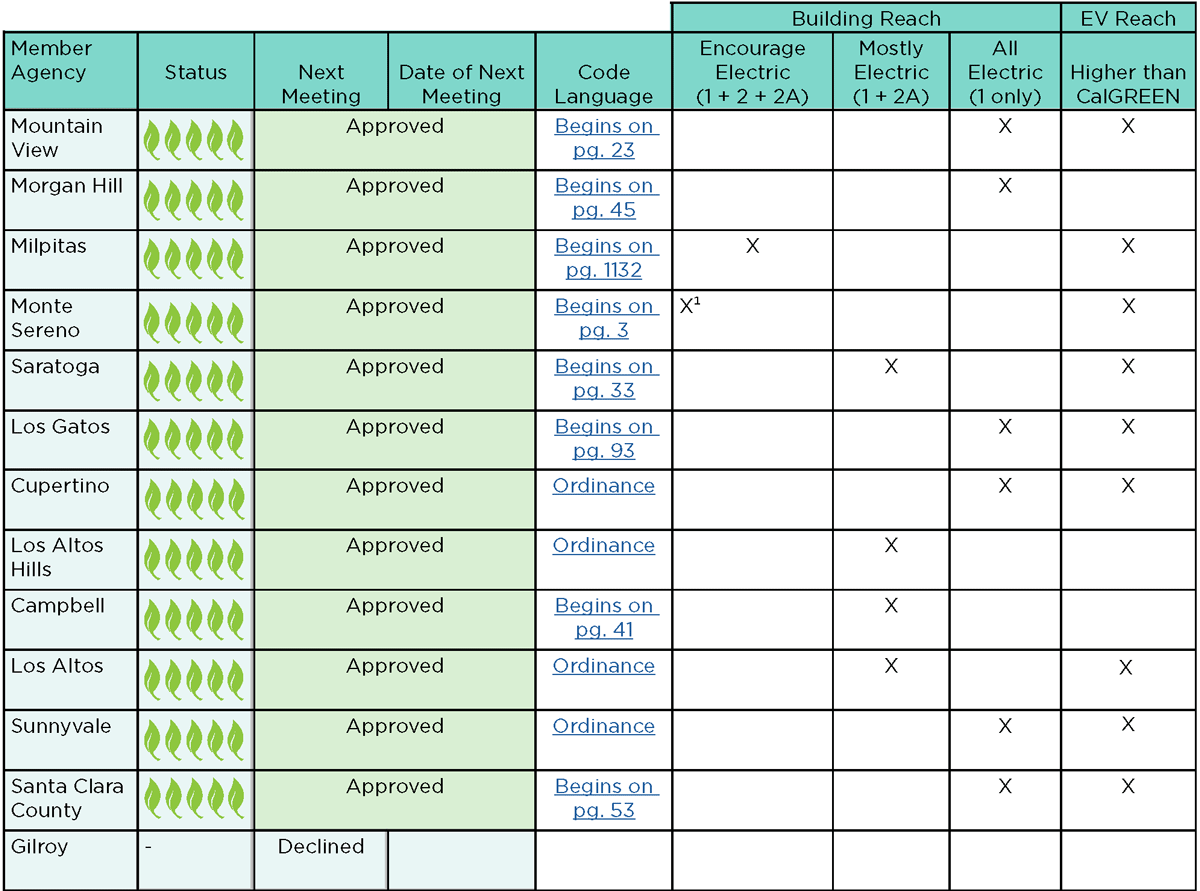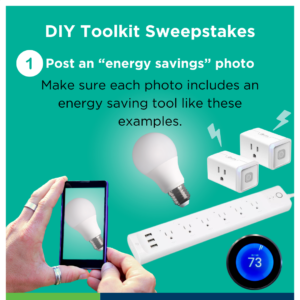A Better Building Code
A better building code keeps construction costs low, prevents pollution, and utilizes clean energy from the grid.
Keep Costs Low
New Construction – all-electric homes and offices cost less to construct than buildings using a combination of electricity and gas.
Utility bills – all-electric buildings have utility bills similar to or less than mixed fuel buildings when using the same construction budget.
Prevent Pollution
Electric appliances emit no toxic pollution, unlike their gas-powered equivalents. Children growing up in homes with gas stoves have a 42 percent higher risk of experiencing asthma in their lifetime.*
Utilize the Grid’s Clean Energy
Fossil fuel usage is at an all-time low and declining in the overall grid and increased local demand will be met by clean sources via SVCE, not fossil fuels.
All-electric can help with resilience because new gas appliances require electricity to function, energy resiliency is best managed with battery storage or in some instances for critical facilities with a generator.
Videos to learn more!
2020 Community Reach Code Adoption
In 2019, Silicon Valley Clean Energy offered technical support to member jurisdictions that were evaluating options for amending the state’s 2020 building code. Known as Reach Codes, the options allowed communities to decide if and how they would “reach” further than the new state code mandates to encourage either all-electric or all-electric readiness for new buildings.
The effort became a regional movement, by 2022, 12 of Silicon Valley Clean Energy’s 13 member agencies adopted reach codes of varying levels (expand the table below to view each community’s actions). Statewide, more than 50 cities and counties have adopted similar codes in an effort to reduce emissions and achieve our shared climate goals.
Reach Code Adoption Table
Building Reach Code Options (from the chart above) – a summary of the Residential requirements
1 = All-Electric inside the building; May still have gas for outdoor applications, unless otherwise restricted
2 = High Reach (electric + natural gas inside); If allowing this option, it is typically paired with one or more of the following:
a) pre-wiring for future electric appliances when installing a natural gas appliance (+ ~$1500),
b) an increase in energy efficiency requirements (+ ~$1500), and/or
c) an energy resource, like solar thermal or battery storage (+ ~ $7500).
2A = Mostly Electric (electric, except for gas cooking and/or gas drying); If allowing this option, it is typically paired with pre-wiring at the stove and dryer for future electric appliance (+ ~$500)
EV Charging Code Options – because this is quite intricate, we are summarizing only whether the proposed local amendment is less than, equal to, or greater than the drafted code language provided by SVCE. To view community specific EV reach code requirements, checkout the charts linked in the buttons titled EV Reach Code above.

2022 Building Electrification & EV Infrastructure Reach Code Initiative
Building on the local movement of cities and counties advancing all-electric new buildings, in 2021, the California Energy Commission adopted a 2022 Energy Code that advances electrification by encouraging efficient, electric heat pumps, and establishing electric-ready requirements for new homes.
Silicon Valley Clean Energy, in partnership with fellow Bay Area Community Choice Energy providers East Bay Community Energy and Peninsula Clean Energy, is again offering support to local jurisdictions that would like to renew all-electric codes from the previous cycle, or establish local ordinances that mandate all-electric construction in their communities.
The 2022 Reach Code initiative offers support for building electrification and Electric Vehicle infrastructure for new construction and existing buildings. Available resources for municipalities include: model codes, stakeholder meeting support, ongoing technical assistance, online resources at BayAreaReachCodes.org, and a $10k grant for city staff time if reach codes are brought to a council vote.
Frequently Asked Questions
Does PG&E have enough transmission capacity for the expected increase in electricity demand?
This answer has two parts – in general and then specific to a project location.
Generally speaking, yes, PG&E has enough transmission capacity. New construction accounts for a very small fraction of overall electricity usage and occurs gradually, enabling PG&E time to accommodate.
At the site level, all projects are reviewed for impact on the local transformers and lines. This will continue. PG&E has been a participant in the reach code effort since the beginning and sent letters of support to all cities considering a reach code.
Does SVCE have enough generation capacity for the expected increase in electricity demand?
SVCE regularly reviews customer load compared to our energy contracts. We began funding the development of new renewable resources starting in 2017 and continue to do so for this very reason.
What might be the positive or negative impact on a residential electricity bill for an all-electric home?
Using the same construction budget, all-electric homes provide similar or lower utility bills than comparable homes using gas.
What type of energy is on the grid?
SVCE is responsible for the electricity purchases for its territory. All sources are carbon-free. Load growth will also be met with carbon-free sources. Learn more about SVCE’s power sources here.
Other buyers in the energy market purchase coal or natural gas to meet their regional needs. As renewables have increased, fossil fuel usage has decreased. Over the last 10 years, natural gas is down from 45% to 35% today. Coal is down from 18% to just 3%. Renewables have increased from 11% to 31% over that same period. All load-serving entities have a choice in what they buy.
https://ww2.energy.ca.gov/almanac/electricity_data/total_system_power.html.
Doesn’t renewable energy cost more?
This certainly was true a decade ago. However, the cost of new generation coming from carbon-free sources is competitive to and often less costly than new natural gas power plants.
Isn't gas still used when the sun goes down?
More correctly, something other than solar must be used when the sun goes down. This can be met by hydro, wind, natural gas peakers, and now by large scale battery storage often recharged by solar as SVCE has done.
Oakland to swap jet fueled peaker plant for urban battery
SV Clean Energy Signs major contracts for California’s largest solar-plus-storage projects
Is gas more resilient?
PG&E is also required to shut down gas service during fires and/or earthquakes. Gas service was shutoff for tens of thousands during Camp and Kincaid Fires, some for over 10 days.
For new buildings with gas appliances, having gas service does not improve resiliency as new gas appliances require electricity for ignition and motors to function. This includes tankless water heaters, furnaces, gas dryers, gas ranges (especially with digital controls). Resilience is best handled with battery storage, propane (long storage life) generators or both.
Aren’t fuel cells twice as efficient as natural gas power plants?
True but somewhat misleading. If all electricity were produced in this fashion, emissions within PG&E territory would actually rise compared to their current power mix, not reduce. Even PG&E purchases most of their electricity (about 85%) from sources currently cleaner than this method. Compared to what SVCE purchases, the increased GHG from using natural gas this way would be dramatically worse, as all SVCE sources are cleaner. Any use of this technology in PG&E territory would rapidly move emissions in the wrong direction.
Do gas appliances affect my health?
Burning gas releases multiple harmful byproducts, including carbon monoxide and formaldehyde. “Additionally, cooking emissions, especially from gas stoves, have been associated with increased respiratory disease. Young children, people with asthma, and people with heart or lung disease are especially vulnerable to the toxic effects of combustion pollutants.” – California Air Resources Board
News & Resources
- CA Building Decarbonization: What’s Coming in 2022? NRDC
- Reach codes expanded to unincorporated areas, Los Altos Town Crier
- Mayor de Blasio Signs Landmark Bill to Ban Combustion of Fossil Fuels in New Buildings, New York City Office of the Mayor
- This U.S. city just voted to decarbonize every single building, Washington Post
- Gas Ban Monitor: Calif. count reaches 50 as West Coast movement grows, S&P Global
- Encinitas first city in San Diego region to approve ‘green building’ ordinance, The Coast News Group
- The Fight to Change US Building Codes, Inside Climate News
- California Cities Lead the Way to a Gas-Free Future, Sierra Club
- Acterra Confers Sustainability Awards on Silicon Valley Clean Energy, Peninsula Clean Energy and Bay Area Climate Advocates, April 23, 2021
- Residential Building Electrification in California, E3
- Combustion Pollutants in Your Home, California Air Resources Board
- Smog, Soot, and Other Air Pollution from Transportation, US EPA
- Presentation to SVCE Board, Building Decarbonization Coalition;



